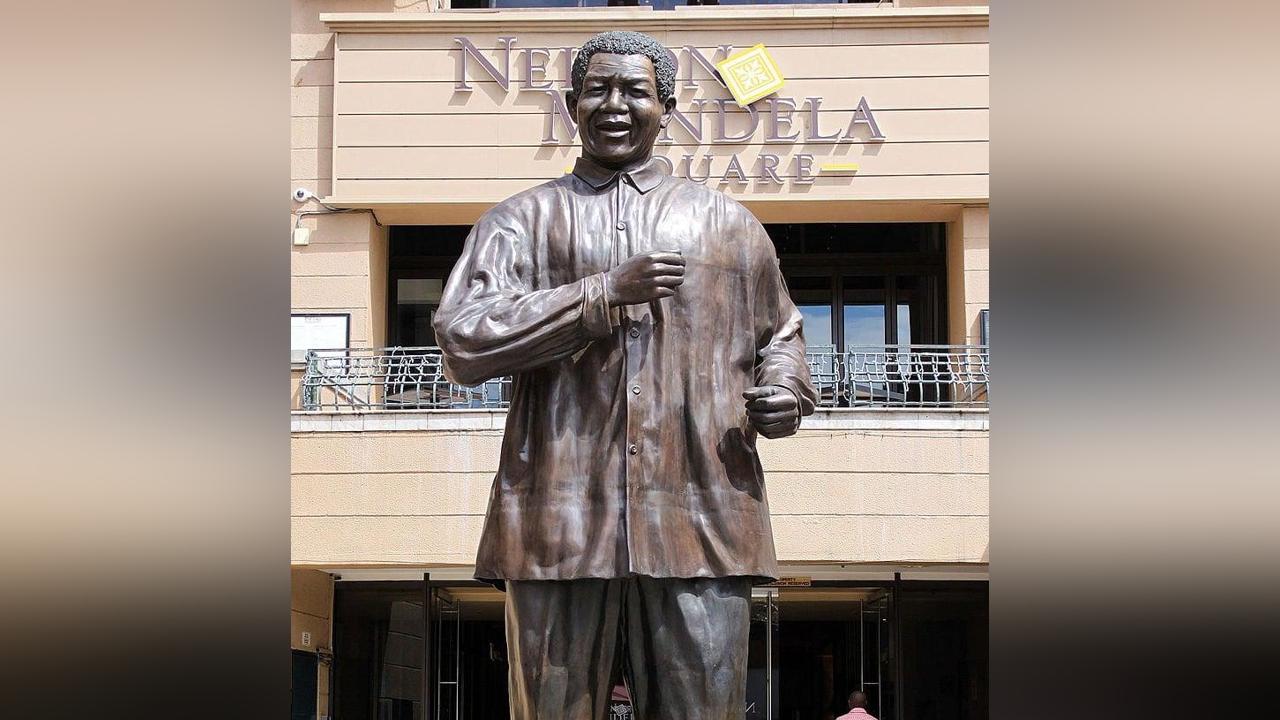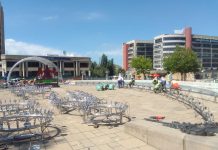Africa-Press – Lesotho. In many countries across the world, statues and monuments are a people’s way of writing public statements of identity. Statues and monuments tell stories that are central to the history of the people in particular places.
The Statue of Liberty in the US is an example. It is noticeable and outstanding due to its presence. The Statue of Liberty is described as “a colossal neoclassical sculpture.
” It is situated on Liberty Island in the New York Harbor in the United States.
Standing 305 feet (93 metres) high including its pedestal, it represents a woman holding a torch in her raised right hand and a tablet bearing the adoption date of the Declaration of Independence (July 4, 1776) in her left.
It is on record that the Statue of Liberty, designed by Auguste Bartholdi (1834-1904), was a gift from France as a symbol of American freedom, and has watched over the New York Harbor since its dedication on October 28, 1886.
The statue was presented to the US, taken apart, shipped across the Atlantic Ocean in crates, and rebuilt in the US. Orature says it all started at dinner one night near Paris in 1865.
A group of Frenchmen were discussing their dictator-like emperor and the democratic government of the US. They decided to build a monument to American freedom — and perhaps even strengthen French demands for democracy in their own country.
At that dinner was the sculptor Frédéric-Auguste Bartholdi. He imagined a statue of a woman holding a torch burning with the light of freedom. The tall statue was the tallest structure in the US at that time.
A plaque at the pedestal’s entrance is inscribed with a sonnet, “The New Colossus” (1883) by Emma Lazarus. It was written to help raise money for the pedestal, and it reads:
Not like the brazen giant of Greek fame, With conquering limbs astride from land to land; Here at our sea-washed, sunset gates shall stand A mighty woman with a torch, whose flame
Is the imprisoned lightning, and her name Mother of Exiles. From her beacon-hand Glows world-wide welcome; her mild eyes command The air-bridged harbor that twin cities frame.
“Keep, ancient lands, your storied pomp!” cries she
With silent lips. “Give me your tired, your poor, Your huddled masses yearning to breathe free, The wretched refuse of your teeming shore. Send these, the homeless, tempest-tost to me,
I lift my lamp beside the golden door!” The Statue of Liberty is one of the most instantly recognisable statues in the world, often viewed as a symbol of both New York City and the United States.
An elevator carries visitors to the observation deck in the pedestal, which may also be reached by stairway, and a spiral staircase leads to an observation platform in the figure’s crown.
Some of the tallest statues in Africa are the 9 metres-tall bronze statue of the late former South African president and anti-apartheid activist Nelson Mandela at the Union Buildings in Pretoria, the African Renaissance Monument which stands on top of one of the twin hills of Collines des Mamelles outside Dakar, Senegal, the Egyptian Sphinx of Giza or just the Sphinx, is a 20.21 metres-tall limestone statue of a reclining sphinx.
The Colossi of Memnon in Egypt are two massive stone statues of the Pharaoh Amenhotep III and the Moremi Statue of Liberty located in Ile Ife, Osun State, Nigeria.
The 9 metres-tall bronze statue of the late former South African president and anti-apartheid activist Nelson Mandela was erected at the Union Buildings in Pretoria, in recognition of the statesman’s extraordinary life and impact on the world.
The statue was unveiled on the Day of Reconciliation on December 16, 2013 by president Jacob Zuma bringing the official mourning period of ten days to a close, after Mandela died on December 5.
It is made of bronze and weighs approximately 3.5 tonnes. From fingertip to fingertip, it measures 8-metres. In his speech during the unveiling, Zuma is quoted as saying: “You will notice that in all the statues that have been made of Madiba, he is raising his fist and at times stretching it.
That derives from the slogan of the ANC. This one is different from many. He is stretching out his hands. He is embracing the whole nation. You shouldn’t say this is not Madiba because we know him with his one [raised] hand.
” About the statue, someone was to write in December 2021: “Tourists take this monument for granted, as something that has always stood here. However, the Mandela monument has been standing on this place for only nine years.
Previously, there was a monument to the hero of the Second Anglo-Boer War, the pre-war Prime Minister of the Union of South Africa Barry Herzog. He was as much a symbolic figure for Afrikaners as Mandela is now for the black majority.
Replacing Herzog with Mandela was a symbolic assertion of power. . . . ” But rather critically, somebody else writes: “Mandela opens his arms vaguely resembling the statue of Christ the Redeemer in Rio de Janeiro.
Not by size, by posture. From an artistic point of view, the statue is not of particular interest. Frankly speaking, not a masterpiece. . . Mandela opens his arms vaguely resembling the statue of Christ the Redeemer in Rio de Janeiro.
Not by size, by posture. From an artistic point of view, the statue is not of particular interest. Frankly speaking, not a masterpiece. . . ” The statue was cast in 147 pieces at four different foundries before being assembled in Cape Town, where the engineering work had been done by the Knight brothers at Sculpture Casting Services Foundry.
Mandela statues can be found in over 24 places around the world, if not more from Cape Town to Cuba, Washington to Ramallah in Palestine, South Africa to Brazil, and elsewhere.
The African Renaissance Monument, which stands on top of one of the twin hills of Collines des Mamelles, outside Dakar, Senegal, is said to be the tallest statue in Africa! It stands tall at 49 metres while others say it is actually 52 metres. Completed in 2010, it is the sculpture in which a man, woman and child stands as a symbol of defiance and future prosperity.
Built overlooking the Atlantic Ocean in the Ouakam suburb, the statue was designed by the Senegalese architect Pierre Goudiaby after an idea presented by president Abdoulaye Wade and built by Mansudae Overseas Projects, a company from North Korea.
The project was launched by the then Senegalese president Abdoulaye Wade who considered it part of Senegal’s prestige projects, aimed at providing monuments to herald a new era of African Renaissance.
It shows a family drawn up towards the sky, the man carrying a child on his biceps and holding his wife by the waist, described as “an Africa emerging from the bowels of the earth, leaving obscurantism to go towards the light.
On April 3, 2010 the African Renaissance Monument was unveiled in Dakar in front of 19 African heads of state, including the President of Malawi and the African Union, Bingu wa Mutharika, Jean Ping of the African Union Commission and the Presidents of Benin, Cape Verde, Republic of the Congo, Ivory Coast, The Gambia, Liberia, Mali, Mauritania and Zimbabwe, as well as representatives from North Korea, and Jesse Jackson and musician Akon, both from the United States, all of whom were given a tour.
President Wade said, “It brings to life our common destiny. Africa has arrived in the 21st century standing tall and more ready than ever to take its destiny into its hands”.
President Bingu of Malawi was quoted saying, “This monument does not belong to Senegal. It belongs to the African people wherever we are. ” In Zimbabwe, the Statue of Mbuya Nehanda is a bronze monument of a Zimbabwean Shona spirit medium and heroine of the 1896-1897 First Chimurenga war against British colonists.
The monument is erected at the intersection of Samora Machel Avenue and Julias Nyerere Way in Harare’s central business district. The 3-metre high statue crafting was guided by a photograph of Mbuya Nehanda Charwe Nyakasikana that was supplied by the National Archives of Zimbabwe.
It was crafted by David Mutasa, a bronze casting artist at Nyati Gallery; construction of the site was carried out by Zimbabwe CRSG Construction. Construction began in June 2020 and during construction, portions of Harare CBD roads including Samora Machel Avenue between Leopold Takawira Street and First Street and Julius Nyerere Way between Sam Nujoma Street and Kwame Nkurumah Avenue were temporarily closed.
Construction was scheduled to be completed by August 2020 but took longer than expected. In December 2020, Zimbabwe President, Emmerson Mnangagwa ordered the statue to be re-crafted after public criticism of the statue’s structure, which did not depict how the only known photo of Mbuya Nehanda looked like, after the statue’s images went viral on social media during the president’s visit to Nyati Gallery.
Charwe, in full Nehanda Charwe Nyakasikana, (born 1862?—died April 27, 1898), one of the major spiritual leaders of African resistance to white rule during the late 19th century in what is now Zimbabwe.
She was considered to be a medium of Nehanda, a female Shona mhondoro (powerful and revered ancestral spirit). Charwe was born among the Shona people, one of Zimbabwe’s major ethnic groups.
She is believed to have become a Nehanda medium during the 1880s; she acquired the mhondoro’s name as a title and was subsequently known as Nehanda Charwe. A defining characteristic of the Chimurenga was its great reliance on African religion, with mhondoro playing a critical role.
Nehanda Charwe, along with the mediums of two other mhondoro—Mukwati in Matabeleland but especially Kagubi in western Mashonaland—found herself organizing and directing her people’s resistance to foreign assaults.
Statues have been produced in many cultures from pre-history to the present; the oldest-known statue dating to about 30,000 years ago. Statues represent many different people and animals, real and mythical.
Many statues are placed in public places as public art. It is claimed that the world’s tallest statue, Statue of Unity, is 182 metres (597 ft) tall and is located near the Narmada Dam in Gujarat, India.
It is often considered that monuments have a spiritual character and iconic value, in the sense that they offer a space for the formation or discovery of meaning.
However, statues have received a fair share of criticism from certain sectors. They are often seen as a waste of resources as their enactment usually involves huge sums of money and consume a lot of time and attention.
They are often seen as objects that demonstrate the domineering nature of those in power at any given time. Some African societies also view statues as outside their culture, approaching idolatry. Regardless, statues still represent the enduring founding values of the people who take time to make and erect them in public places.
For More News And Analysis About Lesotho Follow Africa-Press






